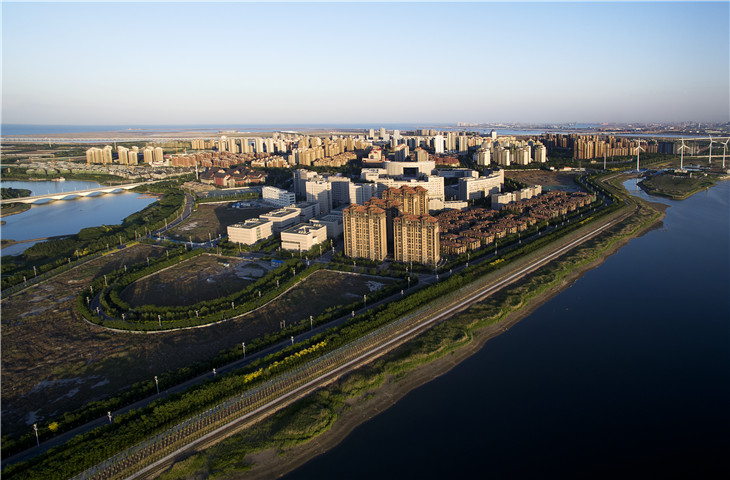


Tianjin eco-city, once a wasteland of northern China, is today a new type of green city thanks to a decade’s joint effort by China and Singapore, People’s Daily reported on Tuesday.
The bilateral cooperation project between Singapore and China kicked off in 2008 on a 30 square kilometers area of wasteland in Tianjin, home to nothing but saline wasteland, salt marshes and polluted waters, with the aim of co-constructing a new model city featuring an earth-friendly environment and social harmony.
After ten years of cooperation, the eco-city, China’s first green development demonstration zone, has taken on a new look. Instead of sewage, marshes and wasteland, people can see the clear river, with greenery flourishing on the saline land.
By 2020, the green coverage rate in this area is expected to reach no less than 50 percent, and the eco-city will achieve 100 percent harmless waste disposal.
In addition, the ecological system in the Tianjin eco-city provides space for living, production and eco-development, integrating industrial and urban development.
The city hosts a variety of leading tech and commerce enterprises such as Huawei, Tencent and Jingdong, new industries such as smart technology and big data, alongside a number of start-up companies, setting an example of sustainable and integrated development.
A group of experts from across the globe gathered near the wasteland and made the world’s first set of 26 standards regarding eco-cities, stating that an eco-city requires 100-percent green buildings, 90 percent environmentally-friendly driving and no less than 20-percent utilization of recyclable energy.
Under the guide of standard mechanism, the Tianjin eco-city piloted new ideas of green development so as to find a solution for other cities across China and indeed the world.
 Fire brigade in Shanghai holds group wedding
Fire brigade in Shanghai holds group wedding Tourists enjoy ice sculptures in Datan Town, north China
Tourists enjoy ice sculptures in Datan Town, north China Sunset scenery of Dayan Pagoda in Xi'an
Sunset scenery of Dayan Pagoda in Xi'an Tourists have fun at scenic spot in Nanlong Town, NW China
Tourists have fun at scenic spot in Nanlong Town, NW China Harbin attracts tourists by making best use of ice in winter
Harbin attracts tourists by making best use of ice in winter In pics: FIS Alpine Ski Women's World Cup Slalom
In pics: FIS Alpine Ski Women's World Cup Slalom Black-necked cranes rest at reservoir in Lhunzhub County, Lhasa
Black-necked cranes rest at reservoir in Lhunzhub County, Lhasa China's FAST telescope will be available to foreign scientists in April
China's FAST telescope will be available to foreign scientists in April "She power" plays indispensable role in poverty alleviation
"She power" plays indispensable role in poverty alleviation Top 10 world news events of People's Daily in 2020
Top 10 world news events of People's Daily in 2020 Top 10 China news events of People's Daily in 2020
Top 10 China news events of People's Daily in 2020 Top 10 media buzzwords of 2020
Top 10 media buzzwords of 2020 Year-ender:10 major tourism stories of 2020
Year-ender:10 major tourism stories of 2020 No interference in Venezuelan issues
No interference in Venezuelan issues
 Biz prepares for trade spat
Biz prepares for trade spat
 Broadcasting Continent
Broadcasting Continent Australia wins Chinese CEOs as US loses
Australia wins Chinese CEOs as US loses